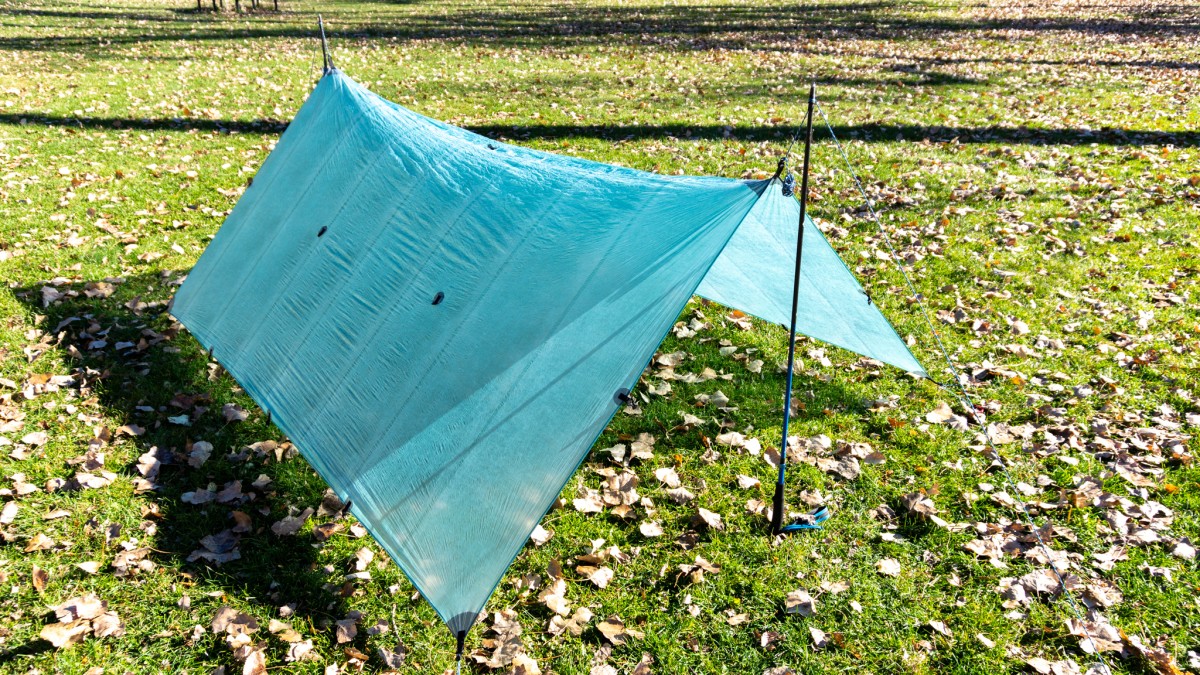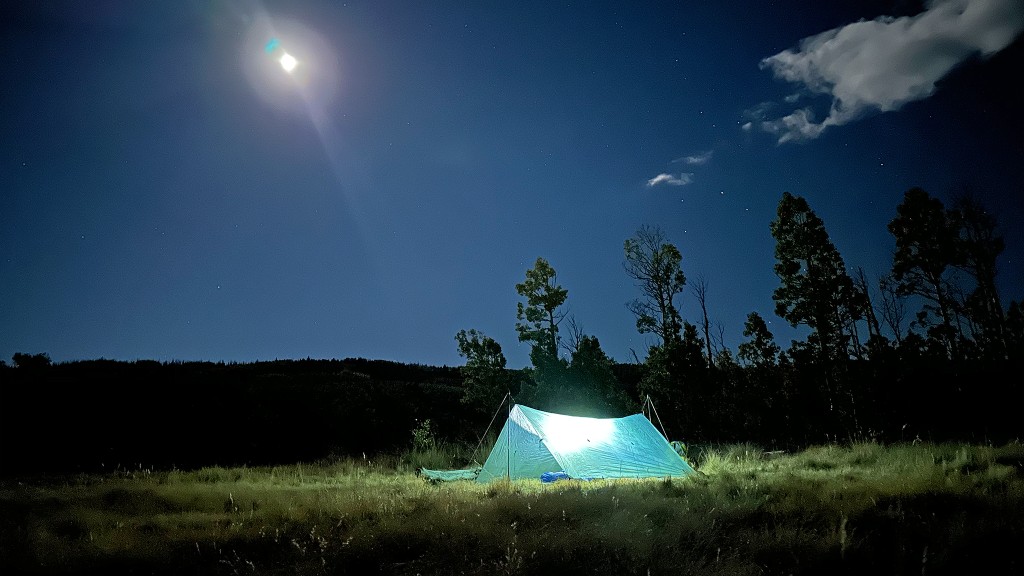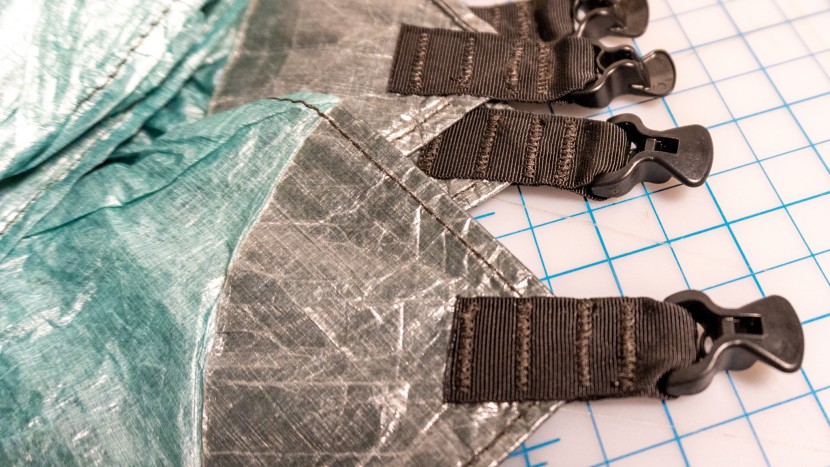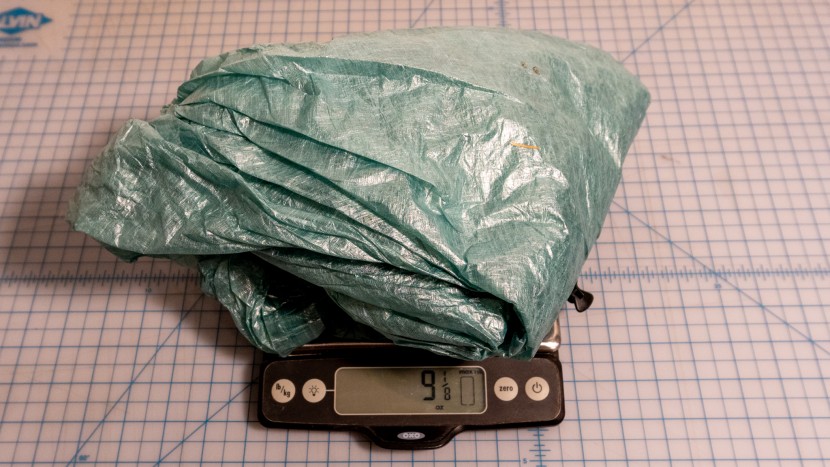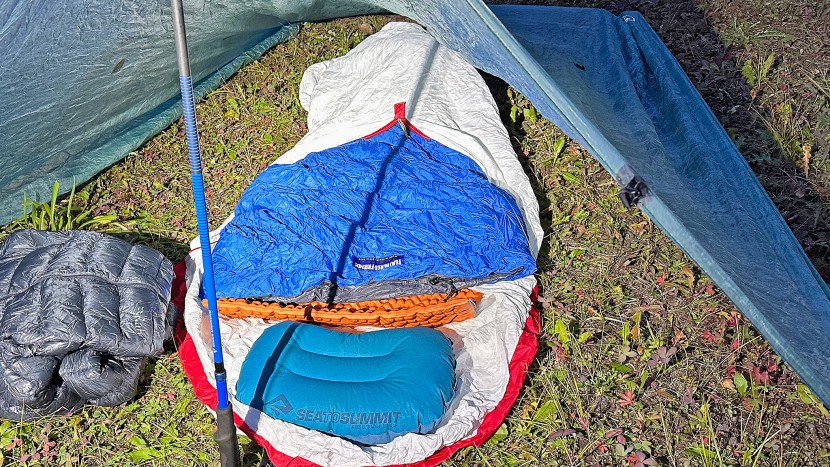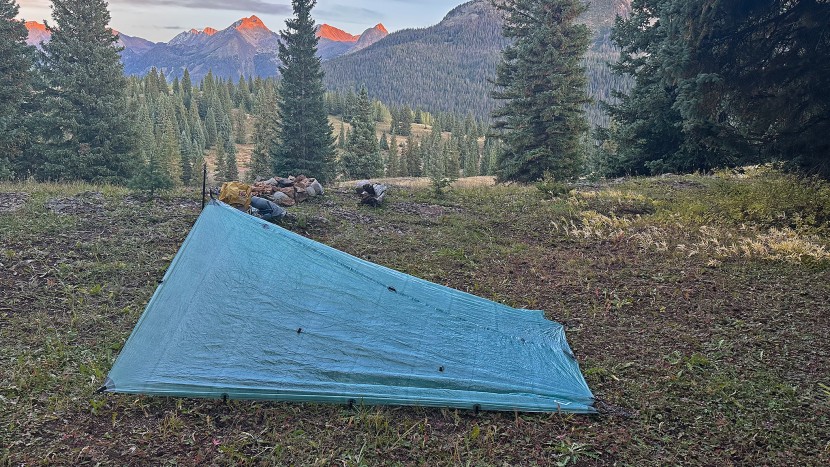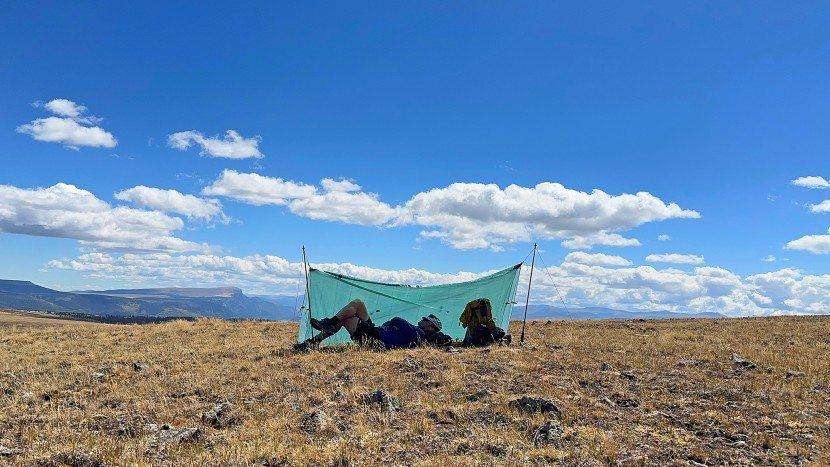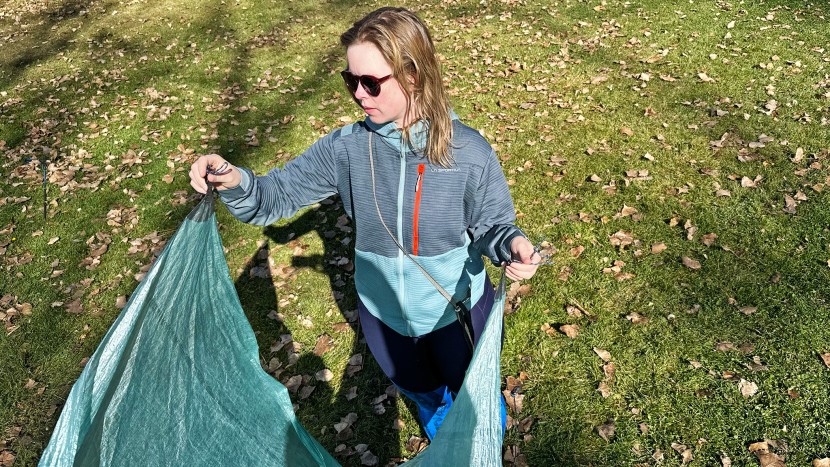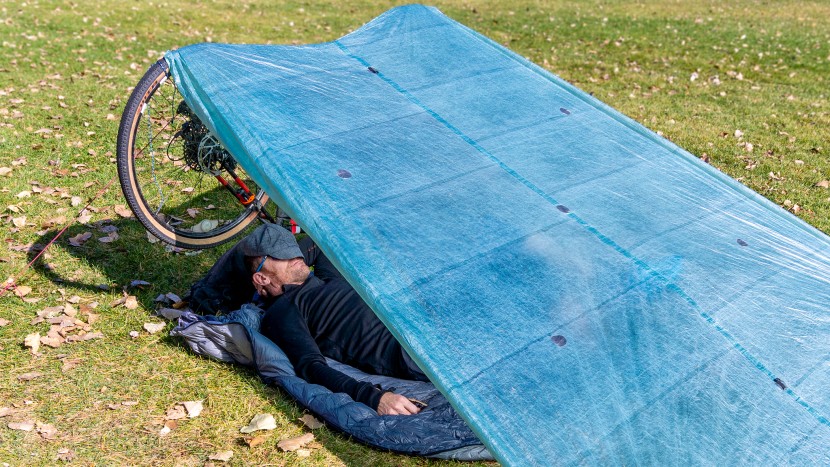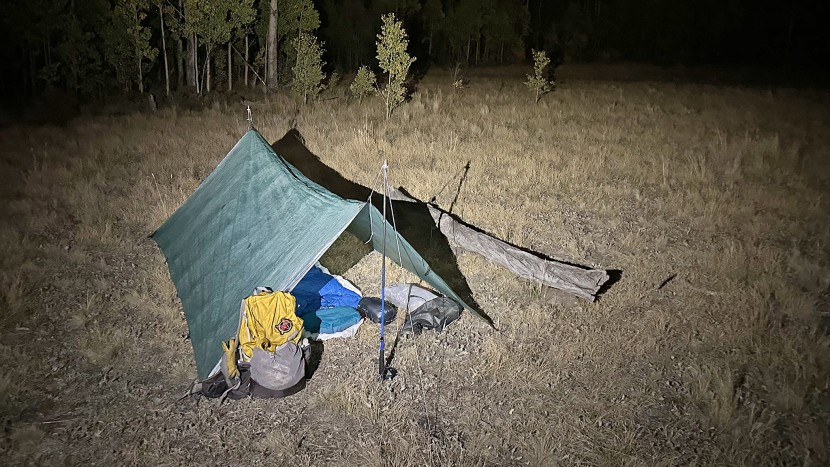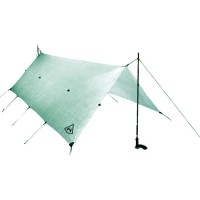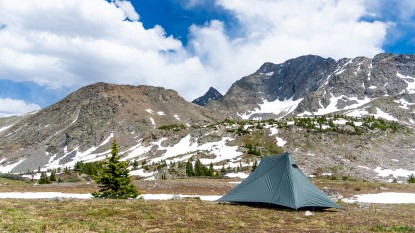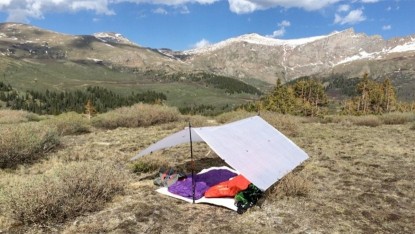
Our Verdict
Our Analysis and Test Results
The Hyperlite Mountain Gear Flat Tarp is the great versipellis — a shelter that's able to change its form to fit exactly the situation at hand. Bring along your trekking poles and a few stakes, and you can set up a simple A-frame in minutes. Storm moving in? Transform your A-frame into a storm pitch before your hiking partner even wakes from their slumber. All this in one of the lightest packages in our lineup. You'll absolutely notice the difference when the tarp is packed up, and you're cruising through the miles with light feet.
Livability
Tarps are what you make of them, but we can't dish out class-leading marks for the Flat Tarp in this metric, as it isn't fully enclosed, has no footprint, and doesn't have bug netting. It's certainly not trying to be anything it's not. This minimalist approach should coerce you to find a perfect solution to your specific needs or have you question if a solution is needed at all. If there are no bugs in the area, why bring a bug net? If you're bringing along a bivy to cowboy camp, is your tarp only there for when it rains?
When it comes to how many people the Flat Tarp can accommodate, it depends on the pitch. A standard A-frame pitch — the pitch you'll likely use most often — will have enough room for two people. If the ceiling is pitched four feet high, the tarp will cover an area six feet wide and eight and a half feet long (51.5 square feet). A storm pitch could be half of this. Spread flat, you'll have almost 74 square feet to work with.
Weight
The Flat Tarp is a true ultralight shelter system. “When I pack for my light-and-fast unsupported FKT attempts, this is the solution I grab for,” admits our lead tester. Weighing 9.21 ounces (261.10 grams) for the tarp alone and 11.32 ounces (320.92 grams) for the tarp and all its included accessories: stuff sack and extra line, it's close to a quarter of the weight of some of the two-pound, two-person tents you also will find in our lineup.
Here's the complete breakdown:
- Tarp: 9.2 oz / 260 g
- Stuff sack: 0.3 oz / 8.5 g
- Extra guy lines: 1.8 oz / 51 g
The caveat here is that you will need to bring your own stakes and poles if you're setting up camp in an area without a lot of natural features. This increases the weight, but again, if you are feeling clever and want to avoid extra weight at all costs, you can head out with just the tarp and line and see what you can come up with.
This featherlight profile goes a long way toward building out a sub-10-pound thru-hiking base weight. Our main tester thru-hiked the Colorado Trail using a 2.5-pound sleep system that included this Flat Tarp, as well as carbon fiber poles, a <500gram zipperless sleeping bag, and a few 11-gram stakes.
Weather Resistance
True weather resistance with the Flat Tarp will depend on your pitch style and location choice. Both go a long way towards having a great night sheltered from inclement weather. It will demand more patience and experience to set this tarp up than it would a full-featured ultralight shelter. The DCF laminate material is waterproof and doesn't stretch, which are both attributes you want to look for to have a fuss-free pitch that doesn't need to be looked at with one eye open during the night. If you need bug protection, you will need a separate mesh system — loops are available to tie and hang such a system.
If foul weather is anticipated, several pitch options are usually employed, including the dart-like “storm pitch” or simply pitching the tarp lower to the ground than you would normally. Both types of pitches will impact the amount of usable space underneath the tarp. That's something to think about if you're sharing this shelter with someone else. “I spent a few spare afternoons myself just playing around in the park, learning different pitching techniques. It's part of the fun of owning a tarp!”, our lead tester tells us.
Adaptability
Adaptability isn't just a trait of the Flat Tarp — it's its whole reason for existing. There is no one way to set up this tarp. Pitch designs and variations are essentially limited to your imagination and remind us of the infinite creations one can make with a square piece of origami paper.
The advantages of the Flat Tarp are clear when camping in areas that can't accommodate a regular tent system. For example, our tester found that in Gates of the Arctic National Park, Alaska, or on certain off-trail sections of the High Sierra Route in California, the pitch flexibility of this tarp allowed him to set up camp in places where he didn't have access to a traditional campsite. Without a specified footprint, it can be as tall, wide, short, or narrow as you need. Use rocks, trees, branches, and what-have-you to set up your shelter to your liking or use the “big rock, little rock” system in lieu of stakes. This tarp invites you to tinker.
Ease of Set-Up
Some people love to follow directions, while others love to figure things out themselves. The Flat Tarp will attract the latter, as there is no one true way to pitch this tarp, and every night out will be a small adventure in spontaneous shelter building. This does require a learning curve, and as you experiment with different ideas, you'll build up your own favorite repertoire of pitch styles. A tarp isn't for everyone, but it could add a new dimension to backpacking and shape what it becomes to you.
The most basic pitch is the Boy Scout A-frame, which is easy enough for anyone to learn but will be a little more difficult than a highly engineered and perfectly designed tent. It involves staking out the four corners of the tarp approximately 5' apart, then attaching poles to the narrower ends. Your tie-down lines will travel from the middle of the shorter side, wrap around your pole, and then stake into the ground. Having your hiking partner help will greatly simplify setup and speed things up.
The incredible DCF material that makes up the Flat Tarp does need a little more tender loving care than sil-nylon. Make sure not to stuff the tarp in its sack, but rather fold it to ensure its long life.
FAQ's
In a nutshell, we think the Hyperlight Mountain Gear tarp is great. But if you're still on the fence about tarp camping, here are a few questions you can ask yourself to know if you're ready to commit to this style of shelter.
Should You Buy the Hyperlite Mountain Gear Flat Tarp?
If an ultra-minimal thru-hiker is what you aspire to become, grabbing the Flat Tarp may be your path towards camping enlightenment. Ultimately adaptable and exceptionally lightweight, this tarp allows you to use your creativity and ingenuity to erect a most righteous shelter anywhere on your hike.
What Other Ultralight Tents Should You Consider?
For a less expensive and perhaps easier-to-use option, check out the SlingFin SplitWing UL Tarp. It's a shaped tarp that can only be set up in one way. For a fully enclosed system that still screams “minimal!” the Zpacks Hexamid should fit the bill. If you need enough room for two people, look into the Six Moon Designs Owyhee Backpacking Tarp. And if tarp-life is too minimal, there are some excellent single-person tents that will still fulfill your ultra-minimal street cred, like the Durston X-Mid 1P and Tarptent Aeon Li.
| Awards | Best Ultralight Tarp |
|---|---|
| Price | $389 List Check Hyperlite Mountain Gear (on sale!) |
Overall Score  |
|
| Star Rating | |
| Bottom Line | This is THE go-to solution when tents are too heavy and you desire maximum versatility |
| Pros | Ultimate flexibility in pitching, extremely simple and lightweight, tons of attachment points |
| Cons | Learning curve to pitching, variable weather protection, no included bug or floor protection |
| Rating Categories | Hyperlite Mountain G... |
| Livability (30%) | |
| Weight (25%) | |
| Weather Resistance (25%) | |
| Adaptability (10%) | |
| Ease of Set-Up (10%) | |
| Specifications | Hyperlite Mountain G... |
| Capacity | 2 person |
| Type | Flat tarp |
| Trekking Poles Needed for Set-up? | Yes, or you can use trees |
| Measured Floor Dimensions | 102 x 102 |
| Measured Weight of Included Parts | Total 11.3 oz; Tarp: 9.2 oz; Stuff sack: 0.3 oz; Extra guy lines: 1.8 oz |
| Weight With All Components | 11.3 oz |
| Measured Floor Area | Depends on configuration |
| Measured Peak Height | Depends on configuration |
| Measured Packed Size | 7 x 6 x 4 in |
| Number of Poles | Variable |
| Doors | 0 |
| Stakes Included? | No |
| Fabric | DCF8 Dyneema Composite Fabrics |


